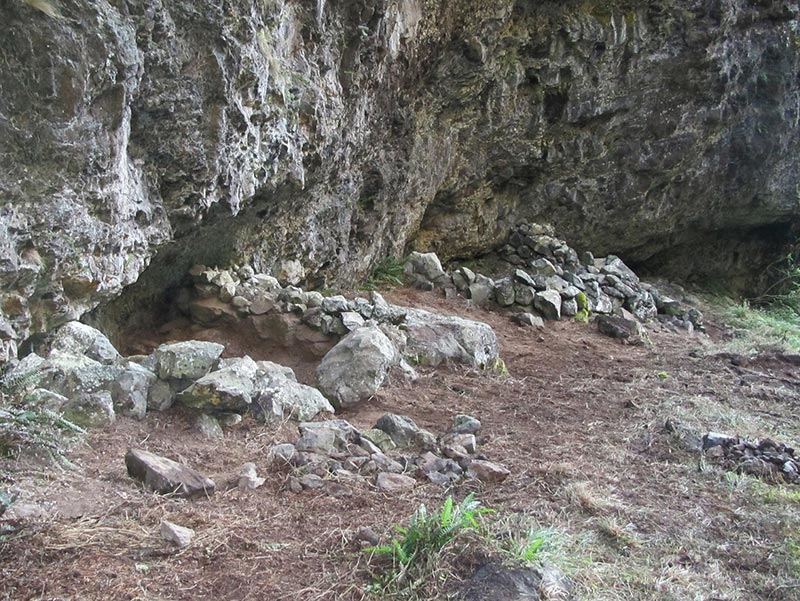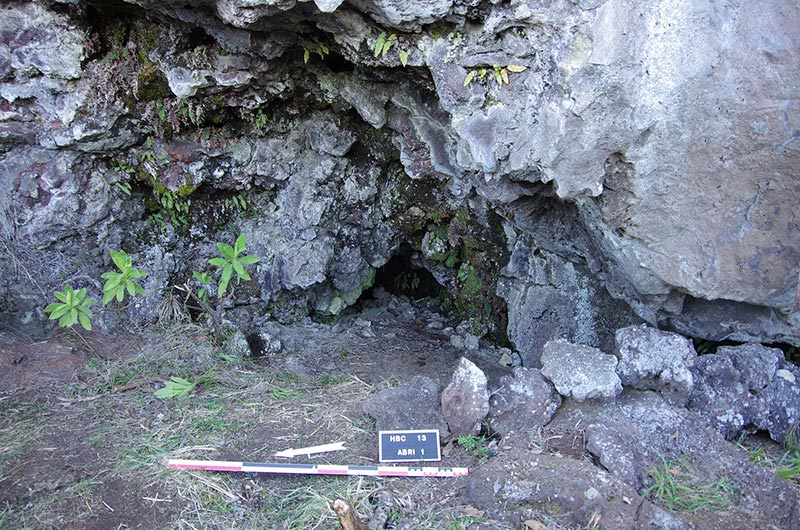This type of resistance existed on all the territories and at all the periods during which populations were reduced to slavery. The word ‘marronage’, derived from the Spanish word ‘cimarrón’, was applied to the ‘wild’ character of a domestic animal gone back to live in its natural environment. ‘Marronage’ or escape, for slaves, was the most direct form of resistance to the system of slavery, since it represented a total and deliberate break from the state of servitude [CAROTENUTO, 2006]. On Reunion island, the phenomenon of escaped slaves or fugitives had only been studied using historical sources, documents from the archives and ethnic-historical accounts produced by the government and the settlers of the period. In the absence of conserved places of memory, its impact can mainly be assessed through the extent of the toponomy, names essentially originating in the the Madagascan language and given to places in the island’s hinterland (Cilaos, Mafate, Salazie etc.). The act of resisting or breaking away from slavery was a widespread historical reality on Bourbon/Reunion until abolition in 1848.
Archaeological interest in the phenomenon of escaped slaves started in the 1960s – 1970s in the United States, then developed elsewhere around the world, making possible the discovery and study of several settlements of escaped slaves in Brazil, in the Caribbean islands, in Surinam and in Mauritius. In Reunion, thanks to the geomorphology of collapsed former caldera, the island’s cirques became natural places of refuge for fugitives as from the end of the 17th century. The first settlers of these steep slopes were escaped slaves [ÈVE, 2003]. For a long time recorded through written historical documents (reports of slave-hunters, legal accounts, interrogations, narratives) the phenomenon of fugitive slaves has, for a short time now, been studied under a new and tangible light, applying the methods of archaeology . Historical documents having demonstrated their limits, today archaeology is the only way to document the way of life of fugitive slaves, through a search for and analysis of material vestiges of their presence, which provide original and at times revealing factual information concerning that period, forgotten or deliberately ignored by History.
Since the end of 2007, a scientific archaeological research programme has been aiming to document the occupation of the mountain areas of Reunion and more specifically the living and survival conditions of fugitive slaves. The existence of an official and regulated regional archaeology department, created in 2010 within the DAC-OI (Department of Culture), has made it possible to carry out archaeological studies in the soil [JACQUOT, 2014]. This search for archives in the soil, in addition to a thorough analysis of the written archives, is starting to reveal the means used by the slaves to survive on a day-to-day basis and has recently brought the first material elements proving the existence of long-term fugitive settlement on the island [DIJOUX, 2014].

Discovered by chance by a mountain guide in 1995, the ‘secret valley’ lies at an altitude of over 2200 m in the cirque of Cilaos. Measuring 450 m in length and 50m in width, it is situated on a steep slope between vertiginous rock-faces of 50m in height. Mentioned neither in archive documents nor oral accounts, the ‘secret valley’ shelters an exceptional archaeological site. Extending over an area of approximately 350m², it is set in the centre of the valley, invisible to outsiders. On its western side, the vestiges consist of a platform presenting bone fragments of fauna close to the surface and further on the eastern side two constructions.
Archaeological studies have unearthed several levels of remains, witnessing the presence of human occupation. In the centre of each shelter, vestiges of a hearth have been unearthed, associated with a large number of remains of fauna, mainly birds, as well as a small number of terrestrial animals. Over one thousand remains of fauna have been discovered. Archaeo-zoological analyses have demonstrated that the inhabitants’ meals consisted mainly of the meat of juvenile birds, unable to fly (Barau’s petrel Pterodoma baraui), completed by the the meat of pigs/boars and goats/sheep. As petrels are present in the valley only in the early months of the year, the site would have been a seasonal hunting stop, viable during this specific season. During the remaining months of the year, it was an impenetrable refuge, but difficult to inhabit for more than a few days, due to the absence of food resources.
In fact, the persons who stayed there only left a small number of objects: a nail, remains of gun-flints, fragments of a kaolin pipe and a few fragments of iron. Their presence is a sign of domestic activity inside the huts: consumption of substances that could be smoked and lighting of fires using gun-flints for ignition. Scientific dating of the pipe fragment indicates that it was last lit in 1822 A.D. ± 13 years, that is to say between 1809 and 1835 AD, the height of the colonial period and of slavery on the island.
The set of data gathered by the archaeologists shows that the ‘secret valley’ was a seasonal refuge for groups of fugitive slaves in search of freedom. This exceptional site, the first, and for the moment the only certain archaeological sign of a long-term fugitive activity on the island, is a spectacular illustration of their desire to survive in extreme conditions.

The archaeological site ‘HBC13’ also culminates at an altitude of 2,200 m, in the sector of the mountain massif of the Piton de la Fournaise, an area first visited by men at the start of the 18th century. On the site, human occupation took place inside a shelter 6,80 m in width and 70 m in height, under a rock. It consists of a wide porch opening out onto the vegetation. The shelter was roughly protected by a low dry-stone wall 2,80 m long and 50 cm high, solely on the eastern side and very rough, but effective.
Archaeological studies carried out in 2013 have shown a succession of temporary constructions, reflected by the presence of a large number of small-size hearths at different spots in various places inside the shelter. A total of 274 bones have been unearthed, indicating the presence of various fauna. Once more, an analysis of the bones confirms a diet mainly consisting of juvenile birds (Barau’s petrel Pterodroma baraui), the nests of which, today no longer present, would certainly have been situated close to the shelter, as well as the consumption of a small number of wild goats.
As in the ‘secret valley’, very few objects have been found in the shelter: two fragments of flints from gun-flints or lighter-flints and the shaft of a nail made of cast iron. The very common nature of these objects during the colonial period makes it impossible to carry out very precise dating of the occupation of the site.
The position of the bones inside the very narrow far end of the shelter indicates its use for waste, while the area covered by the porch and half protected by the low wall was used for cooking, eating and heating.
Data from archaeological exploration coupled with a study of the topographical environment of the site have made it possible to determine the function of the site ‘HBC13’ as being a ‘temporary camp used for exploiting meat (and other) resources in the vicinity’. The chronology of the occupations, covering a period between the 18th and 19th centuries remains, however, difficult to determine due to the absence of dated objects.
As regards the paternity of human occupation of the site ‘HBC13’, it also remains undetermined due to the material similarity between its short occupation by fugitive slaves, that of slave-hunters stopping there or impoverished white settlers (‘Petits-Blancs’) hunting for game. It is highly likely that these three different groups all occupied the shelter at different points in time, which probably represents a major obstacle as regards the archaeology of fugitive slaves in Reunion.
CAROTENUTO A., 2006 : Les Résistances serviles dans la société coloniale de l’île Bourbon, doctoral thesis under the supervision of C. Dubois, 3 vol., University of Aix-Marseille I.
DIJOUX A.-L., 2014 : « L’archéologie du marronnage à l’île de la Réunion : le site de la ‘vallée secrète’ dans le cirque de Cilaos », in DELPUECH A. and JACOB J.-P. (dir.), The archaeology of colonial slavery, Proceedings of international conference organised by INRAP, CPMHE, MCC and MQB in May 2012, Paris : La Découverte, pp. 245-260.
ÈVE P., 2003 : Les Esclaves de Bourbon, la mer et la montagne, Paris : Karthala, and Saint-Denis-de-La-Réunion : University of Reunion.
JACQUOT E., 2014 : « De la découverte d’un cimetière d’esclaves à la création d’un service d’archéologie à La Réunion », in DELPUECH A. (dir.) et JACOB J.-P. (dir.), The archaeology of colonial slavery, Proceedings of international conference organised by INRAP, CPMHE, MCC and MQB in May 2012, Paris : La Découverte, pp 83-94.